Chapter 15- Mutualism and Commensalism
1/73
There's no tags or description
Looks like no tags are added yet.
Name | Mastery | Learn | Test | Matching | Spaced |
|---|
No study sessions yet.
74 Terms
5 Benefits that interacting organisms might incur to help increase growth, survival, or reproduction
Greater access to nutrients or food
More time available for foraging
Better protection / habitats to hide from predators
Increased dispersal
Increased fertilization / genetic variability via dispersal
3 Costs that interacting organisms might incur to decrease growth, survival, or reproduction
Greater energy expenditure
Less time available for foraging
Increased risk of predation
Species interactions can be categorized by the outcome for each species:
Positive (benefits > costs)
Negative (costs > benefits)
Neutral (benefits = costs)
In positive interactions…
Neither species is harmed and the benefits are greater than the costs for at least one species.
+/- interaction
Parasitism/ Carnivore (Predation) / Herbivory
+/0 interaction
Commensalism
+/+ interaction
Mutualism
Sometimes there is a cost to one or both partners but…
Net effect is positive
For each species the benefits must be greater than the costs
Benefits are not always even between species
Facilitation
Another word for positive interactions
Mutualism
Mutually beneficial interaction between individuals of two species (+/+)
Commensalism
Individuals of one species benefit
Individuals of the other species do not benefit but are not harmed (+/0) relationship
Symbiosis
Two species live in close physiological contact with each other
Symbioses can included
Parasitism (+/ -)
Commensalism (+/0)
Mutualism (+/+)
4 Types of positive interactions
Facilitation
Mutualism
Commensalism
Symbiosis
Mutualism in Humans
Gut Microbiota
40+ trillion microbes
break down undigested carbohydrates (fermentation)
vitamin synthesis
Immune response / food allergies
hormone production?
Cravings?
Fat storage?
Commensalism in Humans
Follicle mites
Most plants form positive interactions with …
Mycorrhizae
Mycorrhizae
Symbiotic associations between plant roots and various fungi
How do plants and Mycorrhizae form positive interactions
The fungi increases the surface area for the plant to take up water and soil nutrients ( over 3 m of fungal hyphae may extend from 1cm of plant root)
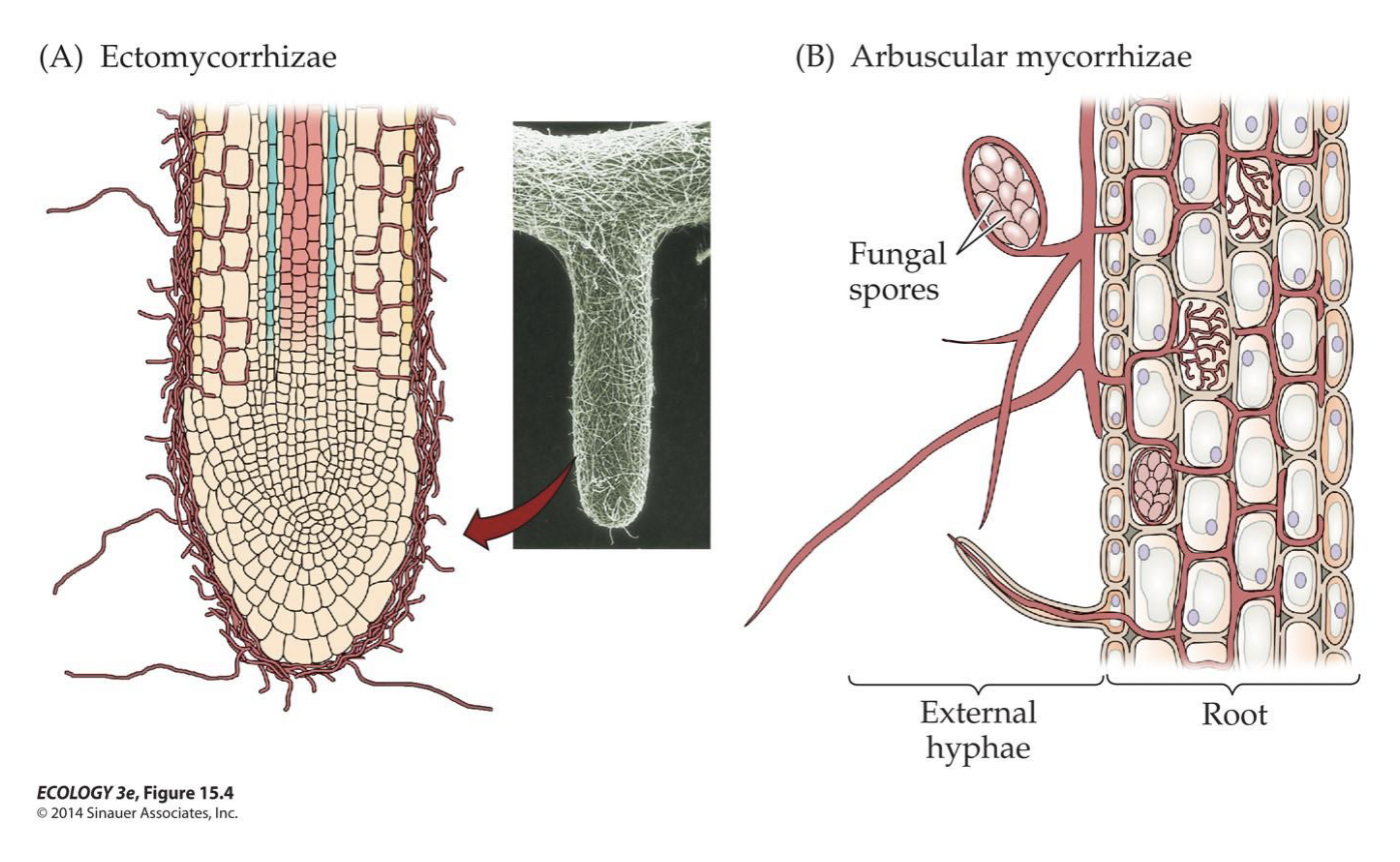
Two types of Mycorrhizae
Ectomycorrhizae
Arbuscular Mycorrhizae

Ectomycorrhizae
The fungal partner grows between root cells and forms a mantle around exterior of root:
hyphae in mantle often extend varying distances in soil
the fungal hyphae form a dense network around the outside of the plant roots, creating a sheath (or mantle). The hyphae penetrate the spaces between root cells but do not enter the cells themselves.
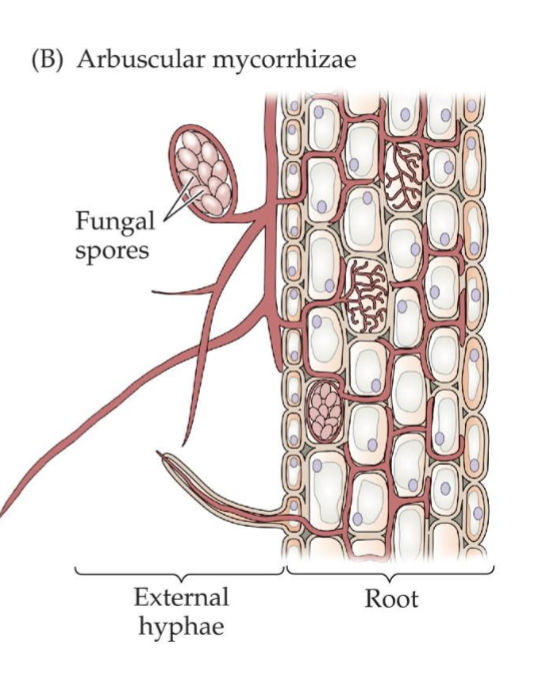
Arbuscular Mycorrhizae
The fungal partner also grows unto soil and it grows between some root cells while penetrating the cell walls of others.
Hyphae that penetrate a root cell and its cell wall but not the cell membrane
The fungal hyphae penetrate the root cell walls and form structures called arbuscules within the cells .
3 fungi plants relationship aspects
The fungi may protect the plants from pathogens
The fungi improve plant growth and survival in a wider range of habitats
The plant supply the fungi with carbohydrates (a cost to the plant that is less than the benefits it receives)
Entangled Life by Merlin Sheldrake
Symbiosis first described for lichens (plant / fungi mutualists)
Lichens in space
“Wood-wide-web”
Maze-solving fungi (slime molds)
Zombie ant fungus

What do corals from a mutualism with
Symbiotic algae
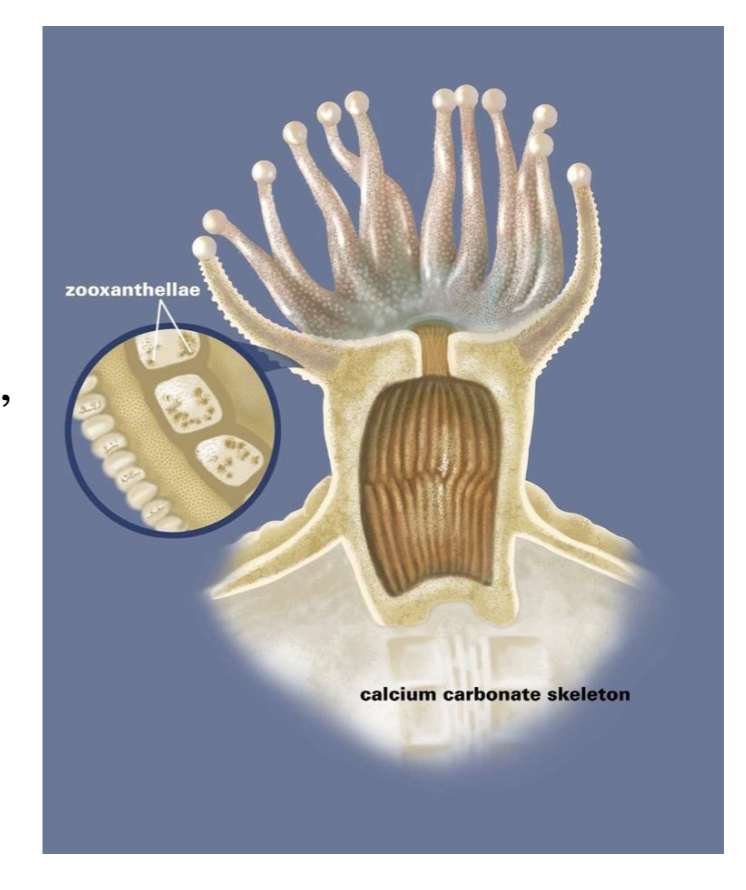
Coral and algae (zooxanthellae) symbiotic relationship
The coral provides the alga with a home, nutrients (nitrogen and phosphorus), and access to sunlight
The alga provides the coral with carbohydrates by photosynthesis

Obligate interactions
Relationships that have coevolved where each organism depends on the other (not optional)

Facultative Interactions
Relationships that are optional (not obligate) and show few signs of coevolution
Wasp and Fig Obligate Interaction Cycle
A pollen-laden female wasp enters the synconium of an unripe fig through an opening known as the ostiole
The wasp lays eggs within some of the flowers in the synconium. In the process the insect pollinates the other female flowers
Flower ovaries that contain wasp larvae form enclosing gall-like structures. The pollinated flowers without larvae produce seeds for the fig plant
As the fig matures, male wasps emerge first from the galls. They then travel the synconium in search of female wasps, fertilizing them while the females are still in their galls
Male flowers have matured by the time masted female emerge from their galls
Without ever leaving the synconium, the wingless male wasps dig escape tunnels for their mates and then die
After collecting pollen from mature male flowers within the ripe fig, each female wasp escapes through a tunnel
The female wasp, carrying pollen, flies to another fig tree in search of a synconium in which to lay her eggs. She dies within the synconium soon afterward.
Coevolution in mutualistic interactions example
Comet orchid (Angraecum Sequipedale)and sphinx moth (Xanthopan Morgani)
Wooly bats and Pitcher Plants in Borneo
Pitcher plants can get their own food by capturing insects.
Bats likely prevent insects from entering (a cost to the plant), but they do produce feces that the plant benefits from.
This is facultative mutualism
Why don’t the ants just eat the leaves?
They cut they leaves from plants to feed then to the fungi in their gardens to help fungal gardens control bacteria and fungal invaders
In turn the fungi produce gongylidia on which the ants feed on
Why doesn’t the fungus just grow on leaves?
The ants scrape a waxy covering from the leaves that the fungi have difficulty penetrating
What are costs/ benefits both the ants and fungus?
The ants scrape a waxy covering from the leaves that the fungi have difficulty penetrating while fungi digest and render chemicals that plants use to kill ants
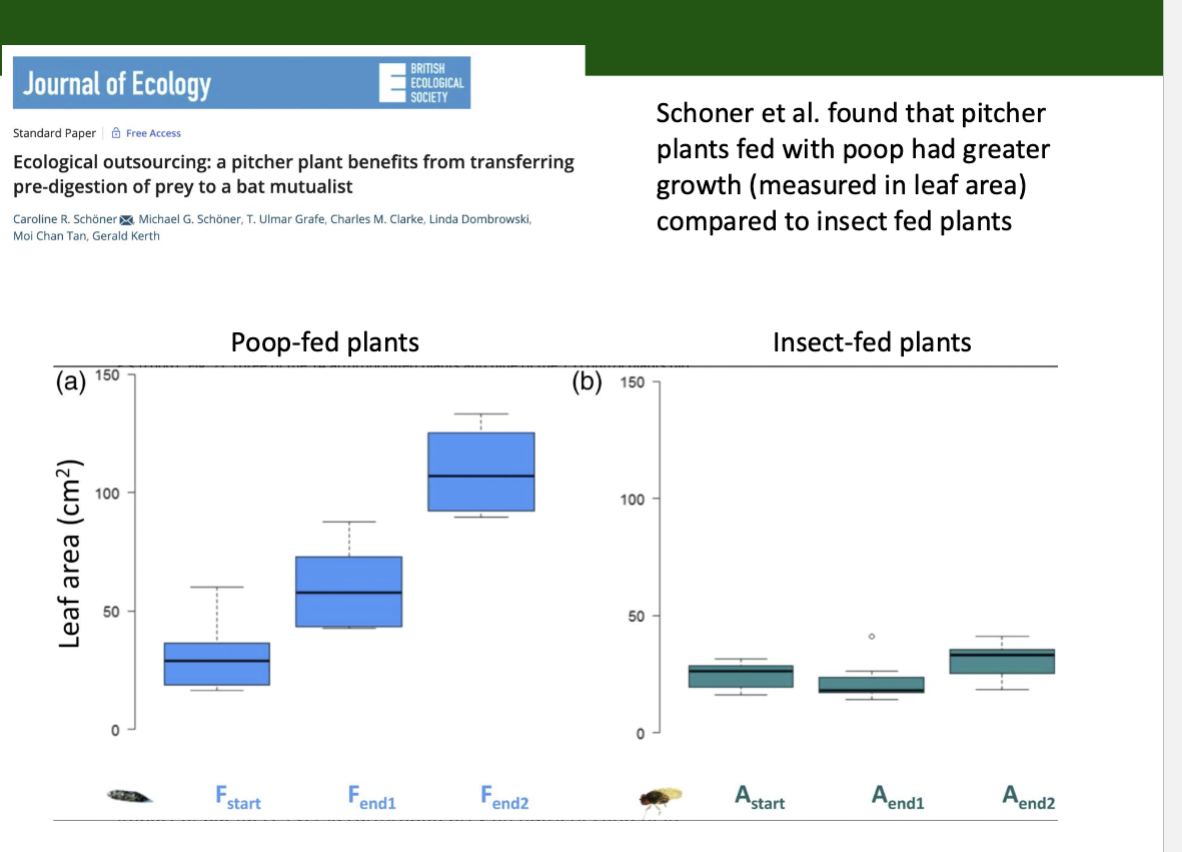
Schoner Finding for Pitcher Plants fed with Poop
Pitcher plants fed with food had greater growth (measured in leaf area) ocmpared to insect fed plants
Examples of where Commensalism can be found
Also everywhere
+/0
Lichens grow on trees
In kelp forests, many species depend on the kelp for habitat and do no harm to the kelp
Understory plants in forests
What kind of relationship is shark and remora?
Commensalism.
Remoras (benefit): These small fish attach themselves to sharks using a suction disc on their heads. They feed on scraps of food left over from the shark's meals and gain free transportation, conserving their energy while moving through the water.
Sharks (neutral): The sharks are generally unaffected by the presence of remoras. The remoras neither harm nor provide a significant benefit to their hosts.
Costs/ benefits between species can vary in…
space and time based on a variety of factors
Therefore, mutualism may be transient(not lasting), and can become commensalism or even parasitism upon the conditions
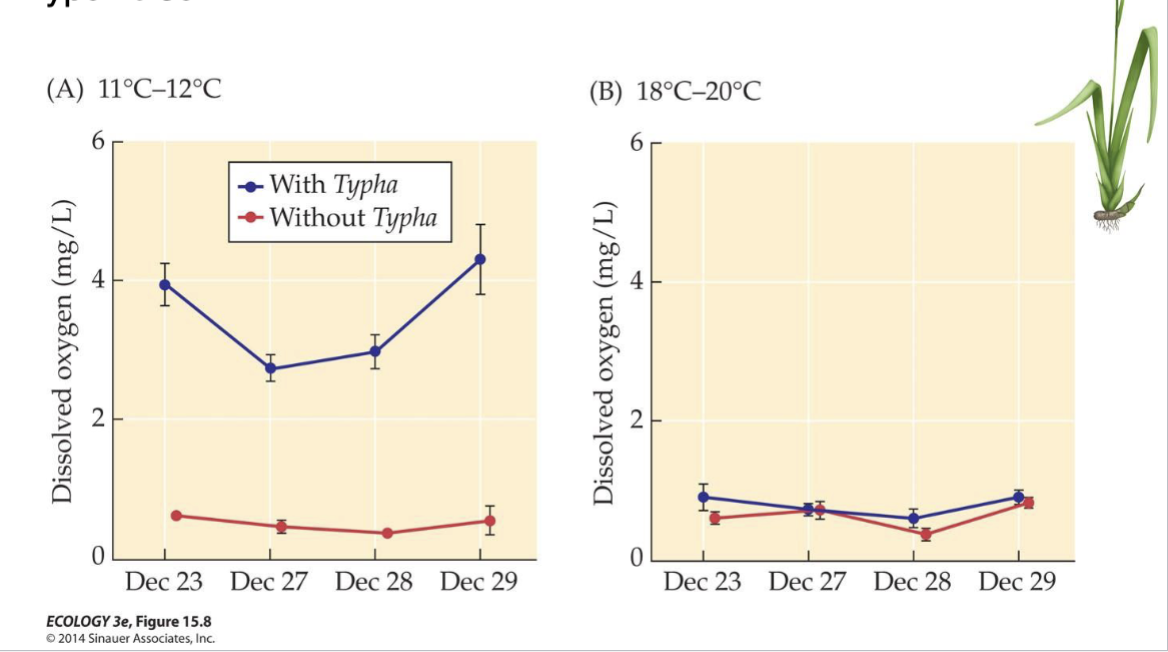
Callaway and King Experiment
Cattails (Typha) and a forget-me-not flower (Myosotis) were grown at different temperatures in hypoxic soil
They grew these plants under two different temperature regimes (11°C–12°C and 18°C–20°C) in pots filled with a mix of natural pond soil and peat, with the soil in the pots submerged under 1–2 cm of water to make it hypoxic. They also grew some pots of Myosotis without Typha under the same conditions
At the low soil temperatures, the dissolved-oxygen content of the soil increased when Typha was present, but that did not happen at the high soil temperatures.
At the low soil temperatures, the growth of Myosotis roots and shoots increased when Typha was present. At the high soil temperatures, however, Myosotis growth decreased when Typha was present
Overall, these results suggest that at the low soil temperatures, Typha provided benefits to Myosotis (perhaps by aerating the soil), while at the high temperatures, Typha had a negative effect on Myosotis—just one example of how a change in environmental conditions can alter the outcome of an ecological interaction

Under cooler temperatures Typha has a positive effect. What kind of relationship is this?
In this scenario:
1. Under cooler temperatures, where Typha has a positive effect, the relationship is an example of mutualism or facilitation. Here, Typha benefits the other species, improving its growth or survival in the cooler, hypoxic conditions. This aligns with the concept of positive interactions where the benefit outweighs any cost, making it a +/+ relationship (mutualism).
Under warmer temperatures Typha has no effect or a possibly
negative effect. What kind of relationship is this?
2. Under warmer temperatures, where Typha has no effect or a negative effect, the relationship shifts to commensalism (if there is no effect, +/0) or potentially competition or a negative interaction (if there is a negative effect, +/- or -/-). In these conditions, the benefits Typha provides are reduced or outweighed by the costs.
Positive interactions can cease to be beneficial under some circumstances
Ex: Soil temperature influences weather a pair of wetland plant species interact as commensals or competitors
STUDY- Positive interactions may be more common in stressful environments: Most comprehensive studies of this type, an international group of ecologists tested the effects that neighboring plants had on a total of 115 target plant species in 11 regions worldwide
In 8–12 replicate plots for each treatment of each target species, neighbors were either left in place or removed from the vicinity of the target species.
The researchers found that RNE was generally positive at high-elevation sites, indicating that neighbors had a positive effect on the target species, but negative at low-elevation sites.
In addition, neighbors tended to reduce the survival and reproduction of target species individuals at low elevation sites, but to increase their survival and reproduction at high-elevation sites.
Callaway et al. determined that the RNE was negatively related to the maximum temperature in the summer, suggesting that positive interactions were more common in colder, more stressful environments and competition was more common in warmer, less stressful environments (FIGURE 15.10) and intertidal communities
(RNE, defined as the growth of the target species with neighbors present minus its growth when neighbors were removed)


What does it mean for RNE (defined as the growth of the target species with neighbors present minus its growth when neighbors were removed) to be positive at high elevation sites?
Indicating that neighbors had a positive effect on the target species, by increasing their survival and reproduction at high-elevation sites
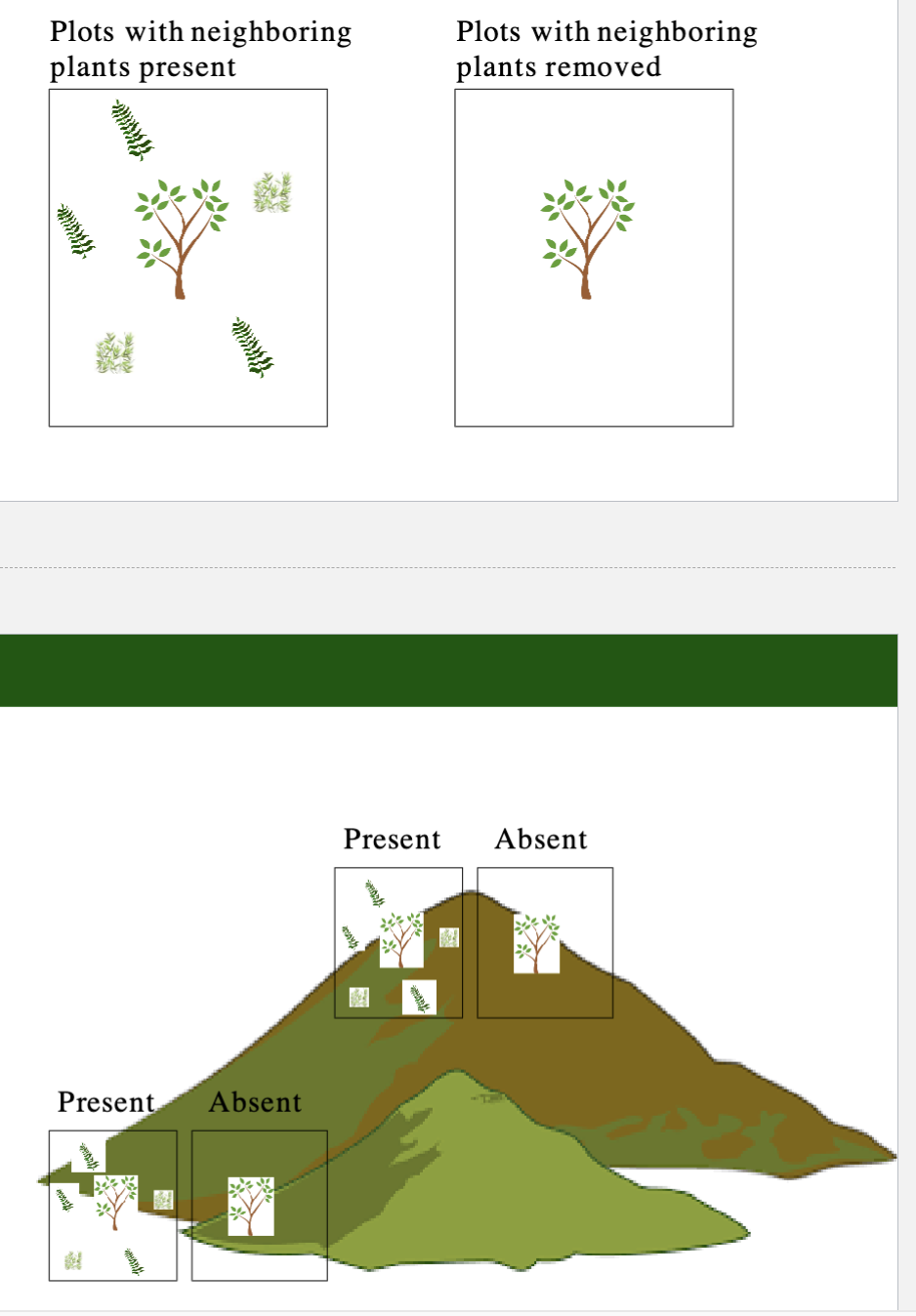
Callaway finding RNE experiment:
Callaway et al. determined that the RNE was negatively related to the maximum temperature in the summer, suggesting that positive interactions were more common in colder, more stressful environments and competition was more common in warmer, less stressful environments (FIGURE 15.10) and intertidal communities
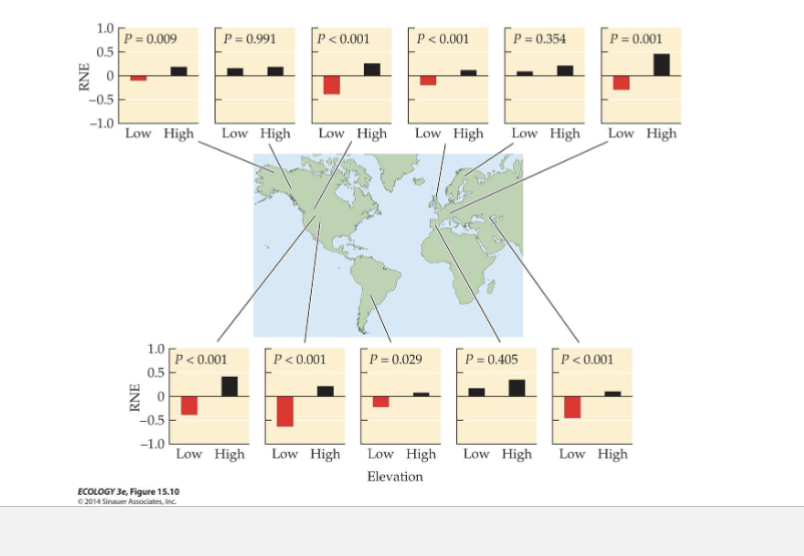
Relative Neighbor Effect (RNE)
Target species’ performance (biomass or leaf #) with neighbors present minus its performance with neighbors removed
Survival for RNE experiment at high and low elevations for when neighbors present
High Elevation, Neighbors Present- High survival
Low Elevation, Neighbors Present- Lower survival compared to higher elevations
Survival for RNE experiment at high and low elevations for when neighbors removed
High Elevation, Neighbors Removed- Low survival
Low Elevation, Neighbors Removed- High survival
Plants producing flowers of fruit for RNE experiment at high and low elevations for when neighbors present
High Elevation, Neighbors Present- Higher percent of plants producing flowers/fruits
Low Elevation, Neighbors Present- Lower percent of plants producing flowers/fruits
Plants producing flowers of fruit for RNE experiment at high and low elevations for when neighbors removed
High Elevation, Neighbors Present- low percent of plants producing flowers/fruits
Low Elevation, Neighbors Present- High percent of plants producing flowers/fruits
3 important reasons why each partner in a mutualistic interaction acts in ways that serve its own ecological and evolutionary interests
The partners in a mutualism are not altruistic.
Both partners take actions that promote their own best interests.
In general, a mutualism evolves and is maintained because the net effect is advantageous to both partners.
3 categories of mutualism
Trophic
Habitat
Service
Trophic Mutualism
Mutualist receives energy or nutrients from its partner.
Leaf-cutter ants and fungus
Mycorrhizae
Examples of trophic mutualism
Leaf-cutter ants and fungus
Mycorrhizae
Habitat Mutualisms
One partner provides the other with shelter, living space, or favorable habitat
Shrimp relies on gobi fish to guard while shrimp makes home
Service Mutualism
One partner performs an ecological service for the other.
Services include pollination, dispersal, and defense against herbivores, predators, or parasites.
Example: The fig–fig wasp pollination mutualism.
Examples of Service Mutualism
Fig-fig wasp pollination mutualism
Services include pollination, dispersal, and defense against herbivores, predators, or parasites
Explain how mutualisms can be classified in more than one category.
For example, pollinators provide a service to flowering plants, while the plants provide food to the pollinator. Thus, this could be classified as both a service and a trophic mutualism.
How would you more accurately classify the shrimp –goby mutualism?
Habitat Mutualism:
The shrimp creates and maintains burrows, providing a safe home for both itself and the goby. This shelter is crucial for the goby, offering protection from predators.
Service Mutualism:
The goby acts as a lookout for predators, using its excellent eyesight to warn the shrimp of potential danger. The shrimp, being nearly blind, relies on the goby's signals for survival
Although both partners in a mutualism benefit, there are also costs.
In a mutualism, net benefits must exceed net costs for both partners.
If environmental conditions change, and benefit is reduced or cost increased for= either partner, the outcome may change, particularly for facultative interactions.
Ants using facultative mutualism
Some ants protect treehoppers from predators, and the treehoppers secrete “honeydew” (sugar solution), which the ants feed on.
Treehoppers always secrete honeydew, so ants always have this resource.
But if predators are few, the tree-hoppers may get no benefit. The interaction shifts from + / + to +/0.

Great-spotted cuckoos and carion crows
Cuckoos are brood parasites – they lay eggs in another species nest for them to raise.
Canestari et al. showed that this parasitism can actually benefit the crows in areas of high predations
3 characteristics of mutualism, they are in it for themselves
A mutualist may withdraw a reward that it usually provides.
In high-nutrient environments, plants can easily get nutrients and may reduce the carbohydrate reward to mycorrhizal fungi.
The costs of supporting the fungus become greater
than the benefits that the fungus can provide.
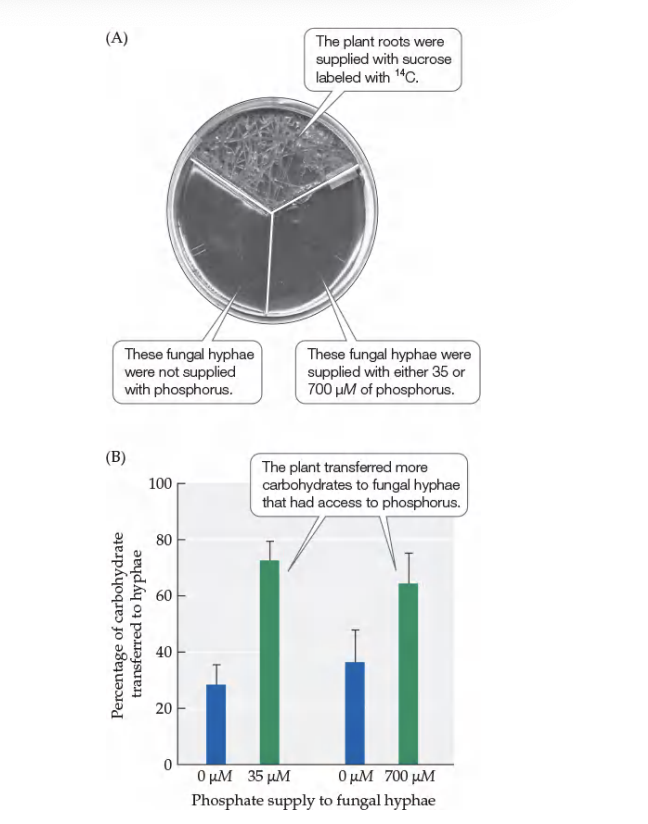
Outcomes of Figure 15.14- Less carbohydrate was supplied to the fungal hyphae on the side of
the petri dish without phosphate Why?
Less carbohydrate (sucrose) supplied to fungal hyphae without phosphorus:
The plant, Medicago truncatula, allocated fewer carbohydrates to mycorrhizal fungi that could not access phosphorus. This indicates that the plant reduces its investment in fungi that do not reciprocate with essential nutrients.
Plants are not altruistic; they optimize resource allocation to maximize their growth and reproduction.
Higher phosphorus concentrations lead to greater carbohydrate allocation:
The fungal hyphae supplied with 35 µM or 700 µM phosphorus received significantly more sucrose compared to the group lacking phosphorus.
This supports the hypothesis that plants preferentially allocate resources to fungi providing greater benefits (phosphorus exchange).
Cheaters
Are individuals that increase offspring production by overexploiting their mutualistic partner
If this happens, the interaction probably will not persist.
Several factors likely contribute to the persistence of mutualisms, although only a few examples are known.
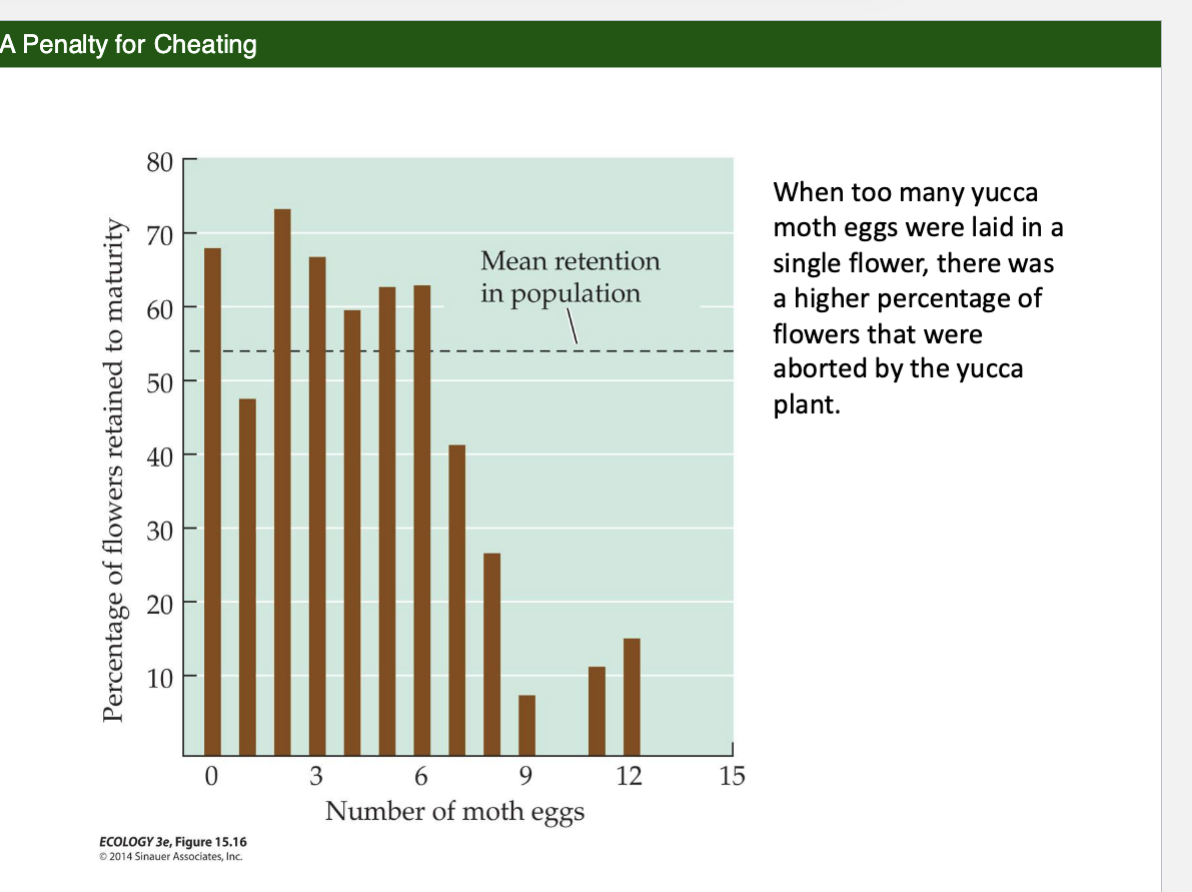
Yucca and Yucca Moths Exploitation
In an obligate mutualism between a yucca and its exclusive pollinator, the yucca moth, the female moth collects pollen in one yucca and lays eggs in another, depositing the pollen in this flower.
Larvae complete development by eating the seeds in the flower.
The moth and the plant depend absolutely on each other for reproduction. However, the mutualism is vulnerable to overexploitation by moths that lay too many eggs and hence consume too many seeds.
When too many yucca moth eggs were laid in a single flower, there was a higher percentage of flowers that were aborted by the yucca plant.
The benefits from mutualism and commensalism can ultimately increase…
growth, survival, or reproduction of the interacting species
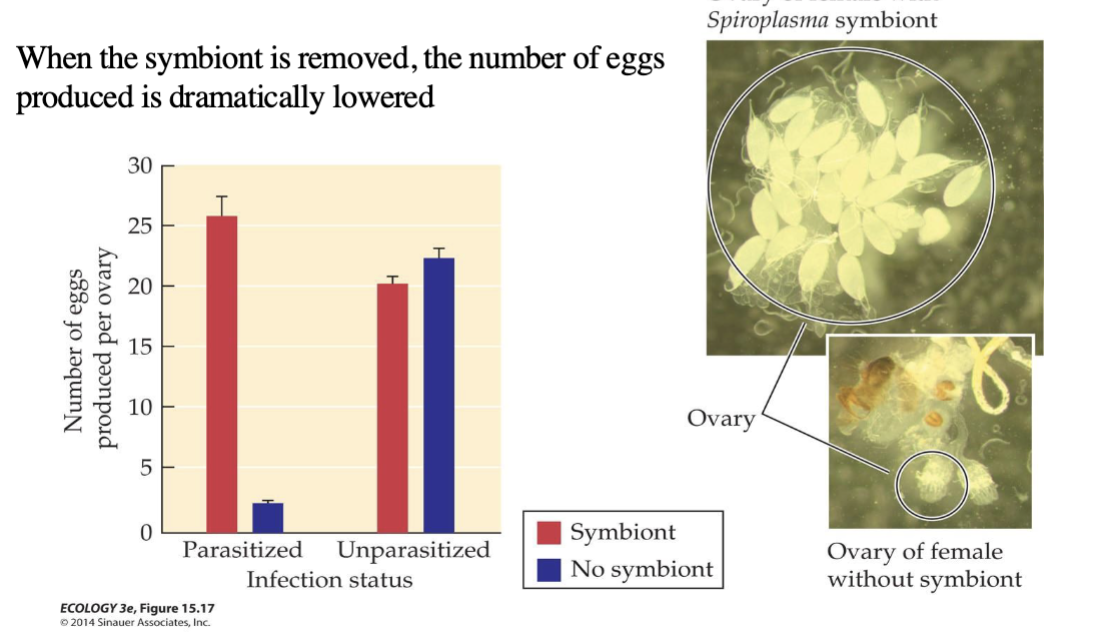
Ecological consequences of positive interactions influence abundances and distribution of populations: Figure 15.16- Symbiont increase the fertility of its host example
Bacteria in the genus Spiroplasma are obligate symbionts that live within the cells of their host, the fruit fly Drosophila neotestacea.
The graph shows the number of eggs produced by laboratory-reared female flies that either had Spiroplasma symbionts (red bars) or did not have Spiroplasma symbionts (blue bars), and that either were infected by the nematode parasite Howardula (parasitized) or were not infected by it (unparasitized). Howardula can sterilize female flies and reduce the mating success of male flies.
When the symbiont is removed, the number of eggs produced is dramatically lowers
Relationship between Ants and acacia trees
Ants protect acacia trees from predators in exchange for nectar and habitat
How would you experimentally determine the benefits that the trees get from the ants?
You can set up plots with ants present and absent and measure different aspects of the acacia tree (abundance, size, percent mortality, growth, etc).
Outcomes of ant acacia trees experiment
Janzen (1966) removed ants from some trees and compared them to trees with ants.
Acacias with ant colonies weighed over 14 times as much as plants without ant colonies..
Acacias without ant colonies are often killed by herbivores in 6–12 months.
$The ants also cannot survive without the trees.
Groups of dominant species commonly determine blank of other species by providing habitat
DISTRIBUTIONS
Many plant and animal species are found only in forests; they cannot tolerate conditions (or competitors) in other habitats.
In rocky intertidal zones, many species live under strands of seaweed that grow on the rocks. The seaweed creates a moist, cool environment at low tide.
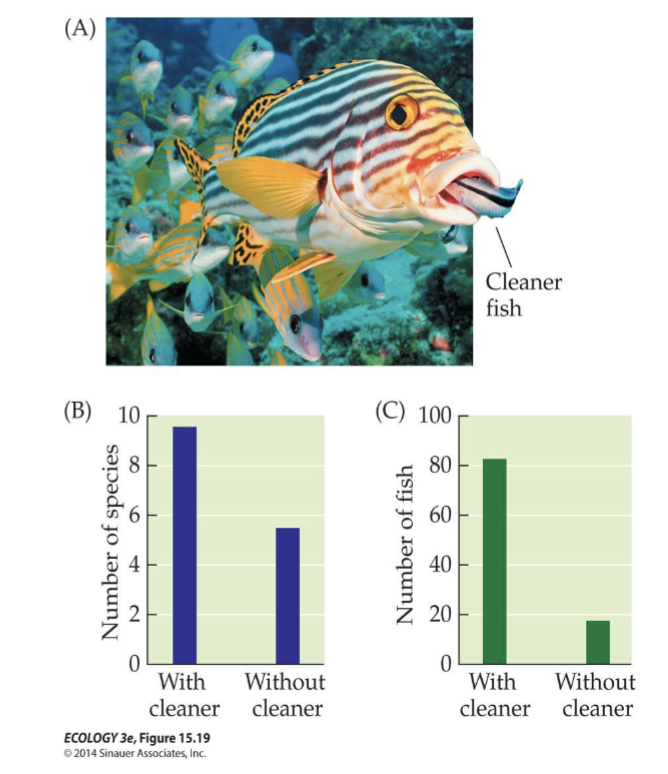
Positive interactions can also influence blank
COMMUNITY COMPOSITION
Many coral reef fish have service mutualisms with smaller organisms (cleaners) that remove parasites from the fish (clients).
The benefit the client receives is greater than the energy benefit it could gain by eating the cleaner
Ex of how communities can be altered by a breakdown in a positive interaction
Coral Bleaching
Community changes: pollinators
Bee colony collapse disorder (CCD) threatens ecosystems dependent on
their pollination services